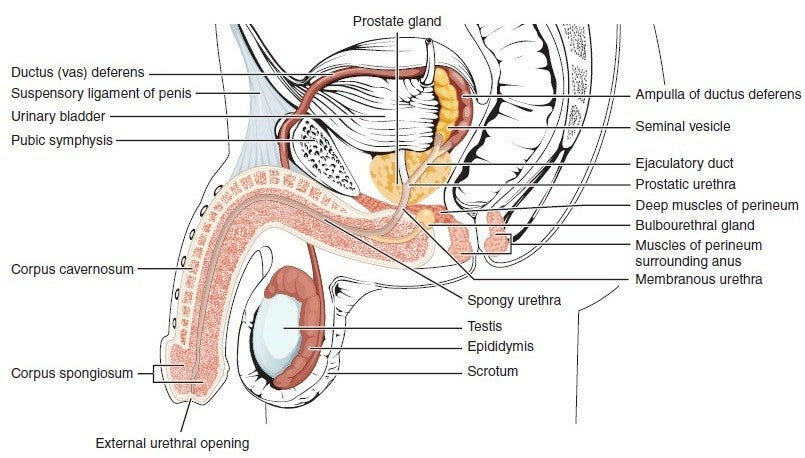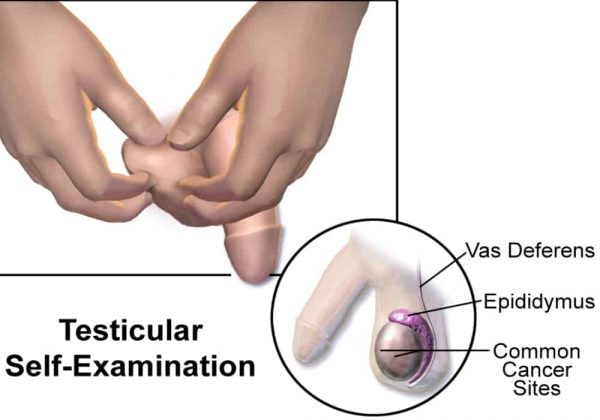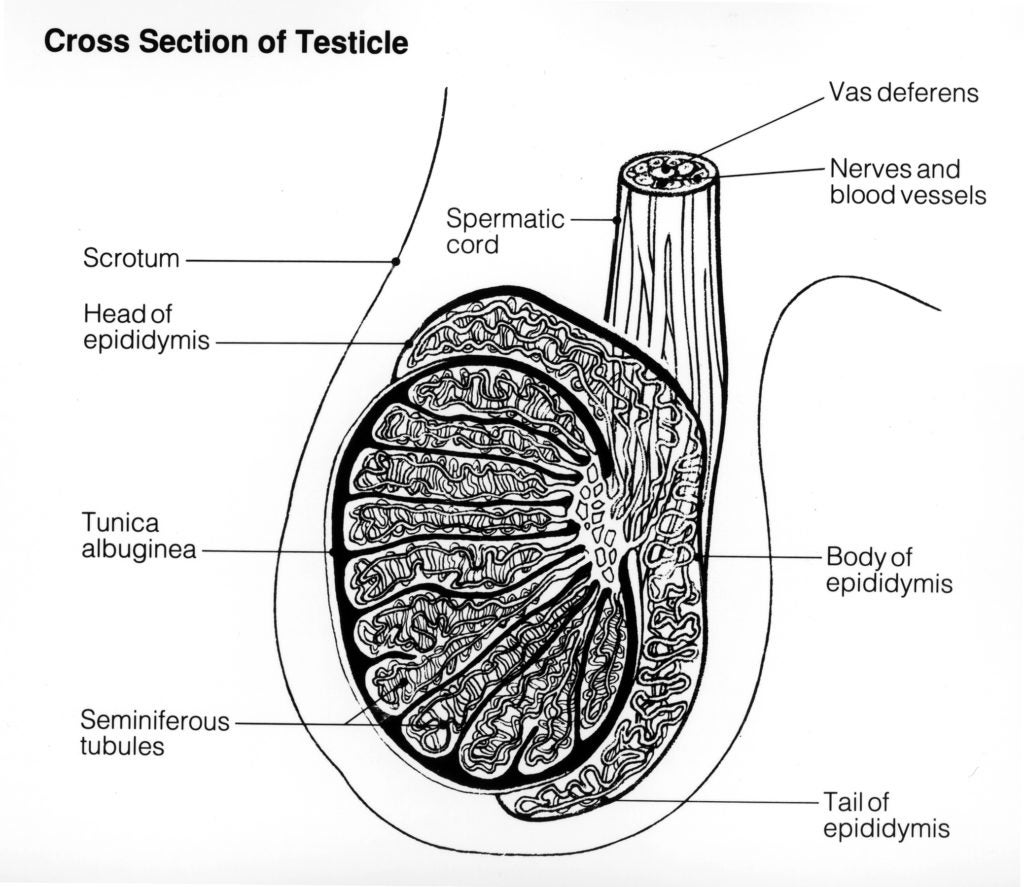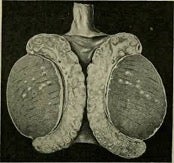
The major regions of the male genitalia include the penis, scrotum, and urethra. A genital self-examination consists of physically and visually investigating for abnormalities. Maintenance of sexual health includes regular self-examination of the external genitalia. Individuals should perform self-examinations as often as possible to identify abnormal masses and avoid complications that may arise from conditions such as sexually transmitted infections.1 Practicing regular self-examination, specifically, examination of the urethra and the testicles, can help individuals familiarize themselves with their own body and distinguish what is normal and abnormal. Examination of the urethra can help identify unusual discharge, which is typically a sign of a sexually transmitted infection (STI), while examination of the testicles can help identify any unfamiliar masses that may be present.1
Table of Contents
When to Perform a Self-Exam
Individuals should perform self-examination once a month, preferably in the shower or a clean environment.2 A hot shower or bath can be beneficial as the heat will allow the testes to descend, making it easier to detect any lumps or abnormalities in testicular shape.2 These monthly self-examinations do not replace proper sexual hygiene or daily visual checks of the genitalia but act as an additional method to ensure there are no abnormalities. If during a daily visual check or monthly self-examination, one is worried about their sexual health, they can contact their trained health professional to be thoroughly examined.
Benefits of a Self-Exam
A self-exam can be a simple method that is easy to perform. One benefit includes avoiding complications with sexually transmitted infections (STI). For example, colored or cloudy urethral discharge can indicate that something may be wrong with the sexual health of an individual.4 Not all urethral discharge means something is wrong, so check with a trained medical professional if one observes any unusual discharge from the urethra. Another benefit of self-exam is the identification of masses. Finding a mass does not mean it is cancerous, as some masses may be benign, but it is imperative that a medical professional be notified so that the appropriate tests may be administered.4 A common misconception of self-examinations is that the act of performing one can prevent testicular cancer. Self-examinations themselves cannot prevent cancer, but rather aid in the identification of masses so that treatment can be administered earlier.5 Testicular cancer is uncommon as the chances developing it is one in 263.3 Even if an individual notices a mass on the testicles, not all masses are cancerous. 3

How to Perform a Genital Self-Examination

A genital self-examination assesses two regions: the penis and the scrotum, as well as the surrounding areas. Assessment of the penis is less important than testicular examinations as cancers associated with the penis are extremely uncommon.5 Less than one in 100,000 people each year are diagnosed with penile cancer.5 Penile examination helps identify problems that testicular examinations cannot such as identify STIs, and vice versa, so it is imperative to perform both examinations.
Examination of the Penis
Self-assessment of the penis is simple to perform. Similar to testicular examination, one should perform this exam in the shower or after washing your body thoroughly to promote cleanliness. First, inspect the penis and surrounding regions. Look for changes in the skin such as any swelling, redness, or bruising.6 Identification of any obvious masses or scars on the penile region should be immediately reported to a trained medical professional.6 The foreskin can be retracted to check for narrowing of the foreskin and any abnormalities involving the head of the penis or the glans. If the foreskin cannot be retracted or if there are any uncomfortable feelings when touching the penis, do not try to further examine the penis and contact a medical professional immediately.6 Check the urethra for any signs of abnormal discharge. Penile examinations are important for maintaining sexual hygiene and are not a replacement for regular visits to the doctor.

Examination of the Testicles

Testicular examinations are a quick method for easy assessment of testicular health. The testicles are two sac-like structures that are held by the scrotum. Testicles are a part of the male reproductive system as they participate in the production and storage of sperm. 2 It is completely normal to have two different sized testes.2 Regular examination can provide an individual with accurate information as to the regular size and shape of the testes, as well as the typical consistency of each testicle.
A testicular examination can be done by following these steps:
- Start with moving the penis out of the way, and assess each individual testicle by gently placing your fingers on either side of the testicle.
- With a small amount of pressure and place one testicle between your thumb and fingers, and gently roll it.
- Feel for any hard lumps and look for any obvious masses.
If any mass is identified that seems abnormal or unusual compared to the regular size and shape of one’s testes, contact a health professional.

Concluding Remarks
Regular self-exams can be beneficial in identifying any abnormalities in one’s sexual health. The penis and testicles are easy to assess, and consistent assessment can contribute to maintaining proper sexual health as one can identify sexually transmitted infections or even cancer.2 Penile and testicular cancers are uncommon, but they are still possible. If one is worried about their sexual health and they feel that a self-exam is not sufficient, they should make an appointment with their doctor to perform thorough tests. Self-exams are not a replacement to regular visits for the doctor or a doctor’s advice.
References
- “Testicular Exam.” Mayo Clinic. Mayo Foundation for Medical Education and Research, 04 Jan. 2018. Web. 16 Apr. 2018.
- “Monthly Self Examinations for Men.” Lakeshore Urology PLC. N.p., n.d. Web. 16 Apr. 2018.
- “Do I Have Testicular Cancer? | Testicular Cancer Symptoms.” American Cancer Society. N.p., n.d. Web. 16 Apr. 2018.
- “How Would I Know I Have an STI?” Think Contraception. N.p., n.d. Web. 16 Apr. 2018.
- “Key Statistics for Penile Cancer.” American Cancer Society. N.p., n.d. Web. 16 Apr. 2018.
- “Male Genital Examination – OSCE Guide.” Geeky Medics. N.p., 31 Mar. 2018. Web. 16 Apr. 2018.
Last Updated: 3 May 2018.
